2009 SKODA ROOMSTER airbag off
[x] Cancel search: airbag offPage 100 of 263
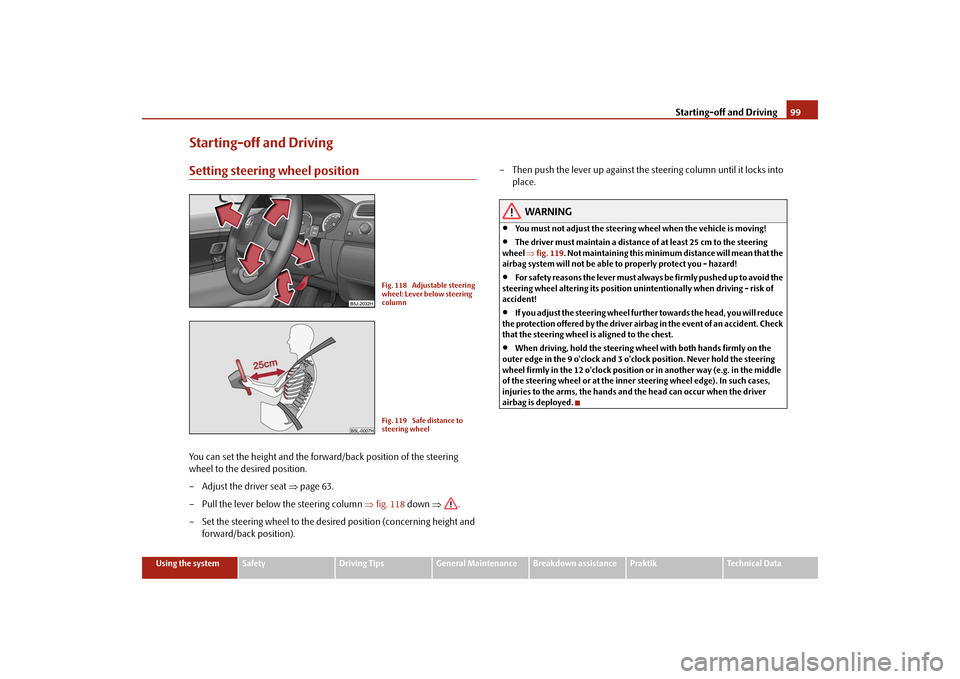
Starting-off and Driving99
Using the system
Safety
Driving Tips
General Maintenance
Breakdown assistance
Praktik
Technical Data
Starting-off and DrivingSetting steering wheel positionYou can set the height and the forward/back position of the steering
wheel to the desired position.
– Adjust the driver seat ⇒page 63.
– Pull the lever below the steering column ⇒fig. 118 down ⇒.
– Set the steering wheel to the desired position (concerning height and
forward/back position).– Then push the lever up against the steering column until it locks into
place.
WARNING
•
You must not adjust the steering wheel when the vehicle is moving!
•
The driver must maintain a distance of at least 25 cm to the steering
wheel ⇒fig. 119. Not maintaining this minimum distance will mean that the
airbag system will not be able to properly protect you - hazard!
•
For s a fe t y re a s ons the le v e r m ust a lwa y s b e fi rm l y pus he d up t o a vo id the
steering wheel altering its position unintentionally when driving - risk of
accident!
•
If you adjust the steering wheel further towards the head, you will reduce
the protection offered by the driver airbag in the event of an accident. Check
that the steering wheel is aligned to the chest.
•
When driving, hold the steering wheel with both hands firmly on the
outer edge in the 9 o'clock and 3 o'clock position. Never hold the steering
wheel firmly in the 12 o'clock position or in another way (e.g. in the middle
of the steering wheel or at the inner steering wheel edge). In such cases,
injuries to the arms, the hands and the head can occur when the driver
airbag is deployed.
Fig. 118 Adjustable steering
wheel: Lever below steering
columnFig. 119 Safe distance to
steering wheel
s29g.4.book Page 99 Wednesday, June 17, 2009 9:54 AM
Page 130 of 263

Passive Safety129
Using the system
Safety
Driving Tips
General Maintenance
Breakdown assistance
Praktik
Technical Data For your own safety and to reduce the risk of injury in the event of an accident, we
recommend the following setting.
•
Adjust the steering wheel so that the distance between the steering wheel and
your chest is at least 25 cm ⇒page 128, fig. 136.
•
Position the driver seat in the forward/back direction so that you are able to fully
press the pedals with your legs at a slight angle.
•
Adjust the seat backrest so that you are able to reach the highest point of the
steering wheel with your arms at a slight angle.
•
Adjust the head restraint so that the top edge of the head restraint is at the same
level as the upper part of your head ⇒fig. 137.
•
Fasten the seat belt correctly ⇒page 134, “How are seat belts correctly
fastened?”.
Driver seat adjustment ⇒page 63, “Adjusting the front seats”.
WARNING
•
The front seats and the head restraints must always be adjusted to match
the body size of the seat occupant as well as the seat belts must always be
correctly fastened in order to provide an optimal protection for you and your
occupants.
•
The driver must maintain a distance of at least 25 cm to the steering
wheel ⇒page 128, fig. 136. Not maintaining this minimum distance will mean that the airbag system will not be able to properly protect you -
hazard!
•
When driving, hold the steering wheel with both hands firmly on the
outer edge in the 9 o'clock and 3 o'clock position. Never hold the steering
wheel firmly in the 12 o'clock position or in another way (e.g. in the middle
of the steering wheel or at the inner steering wheel edge). In such cases,
injuries to the arms, the hands and the head can occur when the driver
airbag is deployed.
•
The seat backrests must not be angled too far back when driving other-
wise this will affect proper operation of the seat belts and of the airbag
system - risk of injury!
•
Ensure that there are no objects in the footwell as any objects may get
behind the pedals during a driving or braking manoeuvre. You would then
no longer be able to operate the clutch, to brake or accelerate.
Correct seated position for the front passenger
The front passenger must maintain a distance of at least 25 cm from
the dash panel so that the airbag offers the greatest possible safety
when an airbag is deployed.For the safety of the front passenger and to reduce the risk of injury in the event of
an accident, we recommend the following setting.•
Adjust the front passenger seat as far as possible to the rear.
•
Adjust the head restraint so that the top edge of the head restraint is at the same
level as the upper part of your head ⇒fig. 137.
•
Fasten the seat belt correctly ⇒page 134, “How are seat belts correctly
fastened?”.
In exceptional cases the front passenger airbag can be deactivated ⇒page 145,
“Deactivating airbags”.
Adjusting the passenger seat ⇒page 63, “Adjusting the front seats”.
Fig. 137 The correct head
restraint adjustment for the
driver
WARNING (continued)
s29g.4.book Page 129 Wednesday, June 17, 2009 9:54 AM
Page 131 of 263
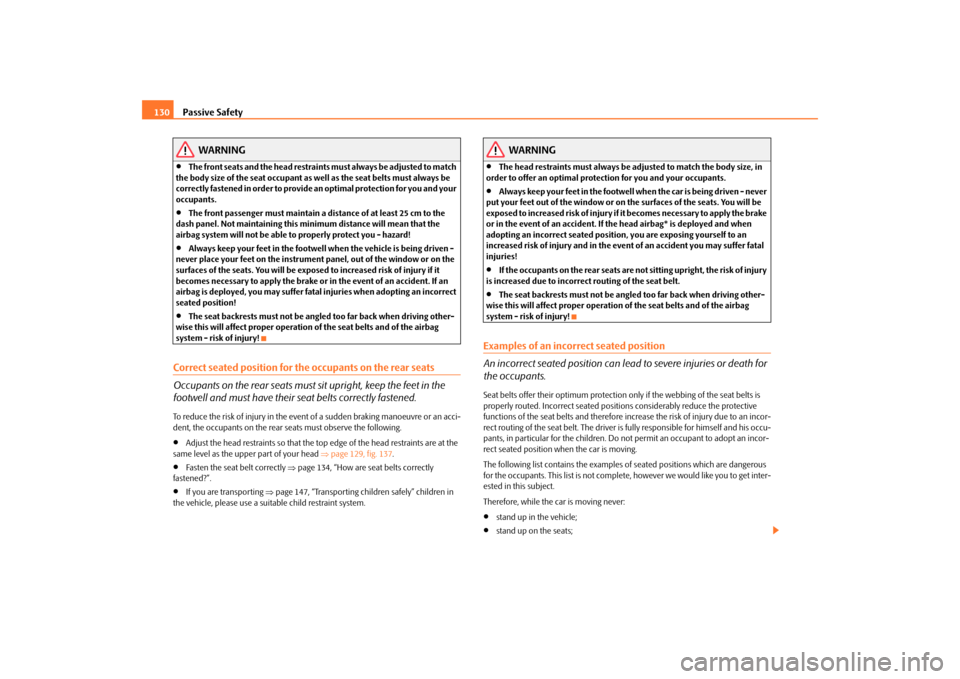
Passive Safety 130
WARNING
•
The front seats and the head restraints must always be adjusted to match
the body size of the seat occupant as well as the seat belts must always be
correctly fastened in order to provide an optimal protection for you and your
occupants.
•
The front passenger must maintain a distance of at least 25 cm to the
dash panel. Not maintaining this minimum distance will mean that the
airbag system will not be able to properly protect you - hazard!
•
Always keep your feet in the footwell when the vehicle is being driven -
never place your feet on the instrument panel, out of the window or on the
surfaces of the seats. You will be exposed to increased risk of injury if it
becomes necessary to apply the brake or in the event of an accident. If an
airbag is deployed, you may suffer fatal injuries when adopting an incorrect
seated position!
•
The seat backrests must not be angled too far back when driving other-
wise this will affect proper operation of the seat belts and of the airbag
system - risk of injury!
Correct seated position for the occupants on the rear seats
Occupants on the rear seats must sit upright, keep the feet in the
footwell and must have their seat belts correctly fastened.To reduce the risk of injury in the event of a sudden braking manoeuvre or an acci-
dent, the occupants on the rear seats must observe the following.•
Adjust the head restraints so that the top edge of the head restraints are at the
same level as the upper part of your head ⇒page 129, fig. 137.
•
Fasten the seat belt correctly ⇒page 134, “How are seat belts correctly
fastened?”.
•
If you are transporting ⇒page 147, “Transporting children safely” children in
the vehicle, please use a suitable child restraint system.
WARNING
•
The head restraints must always be adjusted to match the body size, in
order to offer an optimal protection for you and your occupants.
•
Always keep your feet in the footwell when the car is being driven - never
put your feet out of the window or on the surfaces of the seats. You will be
exposed to increased risk of injury if it becomes necessary to apply the brake
or in the event of an accident. If the head airbag* is deployed and when
adopting an incorrect seated position, you are exposing yourself to an
increased risk of injury and in the event of an accident you may suffer fatal
injuries!
•
If the occupants on the rear seats are not sitting upright, the risk of injury
is increased due to incorrect routing of the seat belt.
•
The seat backrests must not be angled too far back when driving other-
wise this will affect proper operation of the seat belts and of the airbag
system - risk of injury!
Examples of an incorrect seated position
An incorrect seated position can lead to severe injuries or death for
the occupants.Seat belts offer their optimum protection only if the webbing of the seat belts is
properly routed. Incorrect seated positions considerably reduce the protective
functions of the seat belts and therefore increase the risk of injury due to an incor-
rect routing of the seat belt. The driver is fully responsible for himself and his occu-
pants, in particular for the children. Do not permit an occupant to adopt an incor-
rect seated position when the car is moving.
The following list contains the examples of seated positions which are dangerous
for the occupants. This list is not complete, however we would like you to get inter-
ested in this subject.
Therefore, while the car is moving never:•
stand up in the vehicle;
•
stand up on the seats;
s29g.4.book Page 130 Wednesday, June 17, 2009 9:54 AM
Page 132 of 263

Passive Safety131
Using the system
Safety
Driving Tips
General Maintenance
Breakdown assistance
Praktik
Technical Data
•
kneel on the seats;
•
tilt the seat backrest fully to the back;
•
lean against the dash panel;
•
lie on the rear seat bench;
•
only sit on the front area of the seat;
•
sit to the side;
•
lean out of the window;
•
put the feet out of the window;
•
put the feet on the dash panel;
•
put the feet on the seat upholstery;
•
transport somebody in the footwell;
•
have the seat belt not fastened when driving;
•
occupy the luggage compartment.
WARNING
•
If the occupant adopts an incorrect seated position, he is exposed to life-
threatening injuries, in case he is hit by a deployed airbag.
•
Before setting off, please adopt the correct seated position and do not
change this seated position while the car is moving. Also advise your occu-
pants to adopt the correct seated position and not to change this seated
position while the car is moving.
s29g.4.book Page 131 Wednesday, June 17, 2009 9:54 AM
Page 133 of 263
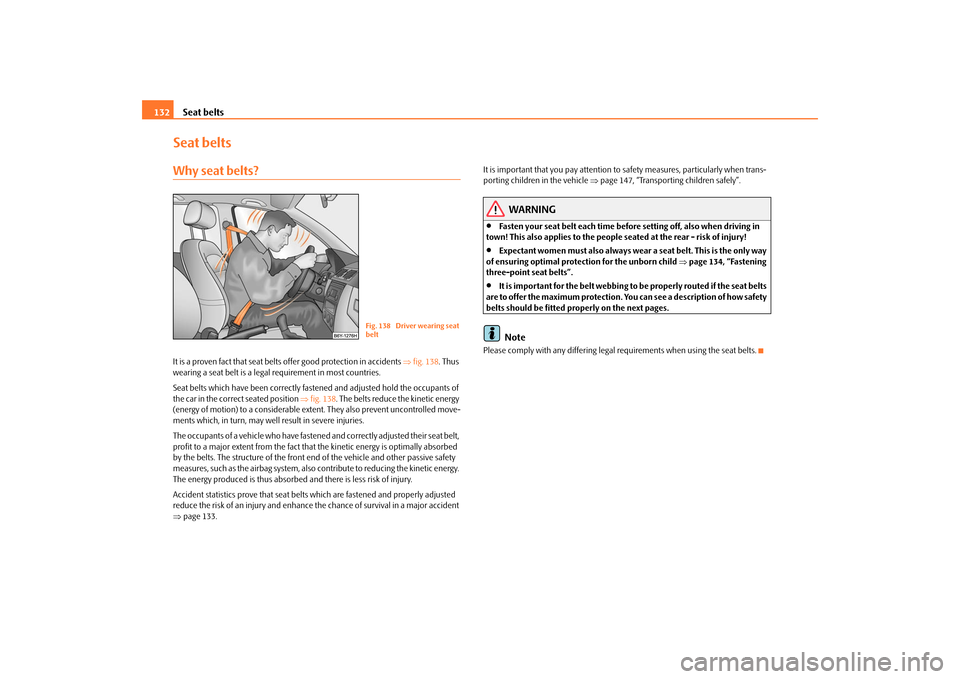
Seat belts 132Seat beltsWhy seat belts?It is a proven fact that seat belts offer good protection in accidents ⇒fig. 138. Thus
wearing a seat belt is a legal requirement in most countries.
Seat belts which have been correctly fastened and adjusted hold the occupants of
the car in the correct seated position ⇒fig. 138. The belts reduce the kinetic energy
(energy of motion) to a considerable extent. They also prevent uncontrolled move-
ments which, in turn, may well result in severe injuries.
The occupants of a vehicle who have fastened and correctly adjusted their seat belt,
profit to a major extent from the fact that the kinetic energy is optimally absorbed
by the belts. The structure of the front end of the vehicle and other passive safety
measures, such as the airbag system, also contribute to reducing the kinetic energy.
The energy produced is thus absorbed and there is less risk of injury.
Accident statistics prove that seat belts which are fastened and properly adjusted
reduce the risk of an injury and enhance the chance of survival in a major accident
⇒page 133.It is important that you pay attention to safety measures, particularly when trans-
porting children in the vehicle ⇒page 147, “Transporting children safely”.
WARNING
•
Fasten your seat belt each time before setting off, also when driving in
town! This also applies to the people seated at the rear - risk of injury!
•
Expectant women must also always wear a seat belt. This is the only way
of ensuring optimal protection for the unborn child ⇒page 134, “Fastening
three-point seat belts”.
•
It is important for the belt webbing to be properly routed if the seat belts
are to offer the maximum protection. You can see a description of how safety
belts should be fitted properly on the next pages.Note
Please comply with any differing legal requirements when using the seat belts.
Fig. 138 Driver wearing seat
belt
s29g.4.book Page 132 Wednesday, June 17, 2009 9:54 AM
Page 139 of 263
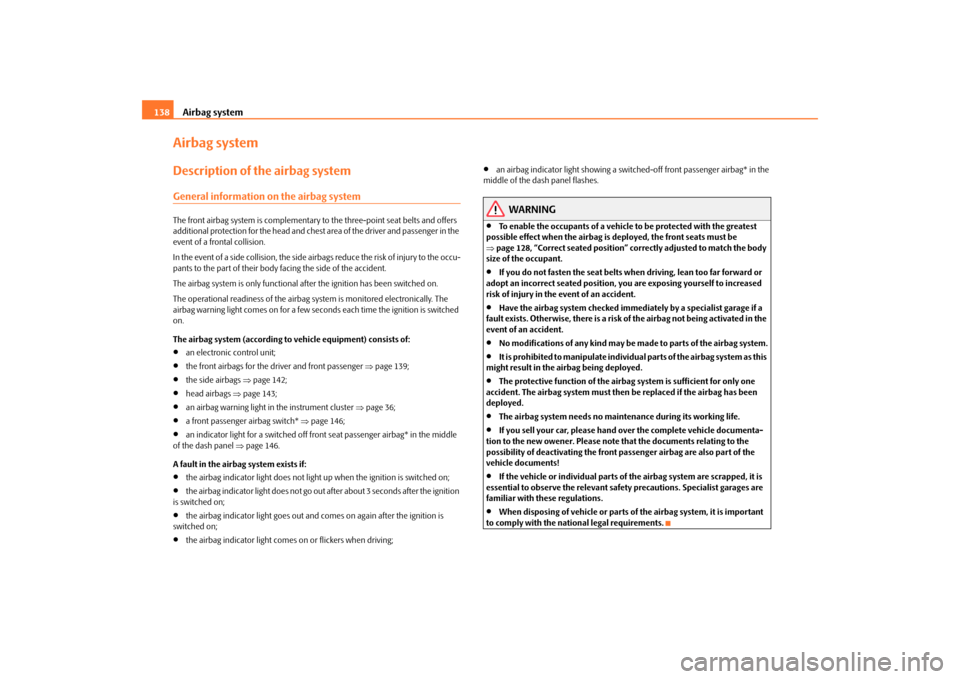
Airbag system 138Airbag systemDescription of the airbag systemGeneral information on the airbag systemThe front airbag system is complementary to the three-point seat belts and offers
additional protection for the head and chest area of the driver and passenger in the
event of a frontal collision.
In the event of a side collision, the side airbags reduce the risk of injury to the occu-
pants to the part of their body facing the side of the accident.
The airbag system is only functional after the ignition has been switched on.
The operational readiness of the airbag system is monitored electronically. The
airbag warning light comes on for a few seconds each time the ignition is switched
on.
The airbag system (according to vehicle equipment) consists of:•
an electronic control unit;
•
the front airbags for the driver and front passenger ⇒page 139;
•
the side airbags ⇒page 142;
•
head airbags ⇒page 143;
•
an airbag warning light in the instrument cluster ⇒page 36;
•
a front passenger airbag switch* ⇒page 146;
•
an indicator light for a switched off front seat passenger airbag* in the middle
of the dash panel ⇒page 146.
A fault in the airbag system exists if:
•
the airbag indicator light does not light up when the ignition is switched on;
•
the airbag indicator light does not go out after about 3 seconds after the ignition
is switched on;
•
the airbag indicator light goes out and comes on again after the ignition is
switched on;
•
the airbag indicator light comes on or flickers when driving;
•
an airbag indicator light showing a switched-off front passenger airbag* in the
middle of the dash panel flashes.
WARNING
•
To enable the occupants of a vehicle to be protected with the greatest
possible effect when the airbag is deployed, the front seats must be
⇒page 128, “Correct seated position” correctly adjusted to match the body
size of the occupant.
•
If you do not fasten the seat belts when driving, lean too far forward or
adopt an incorrect seated position, you are exposing yourself to increased
risk of injury in the event of an accident.
•
Have the airbag system checked immediately by a specialist garage if a
fault exists. Otherwise, there is a risk of the airbag not being activated in the
event of an accident.
•
No modifications of any kind may be made to parts of the airbag system.
•
It is prohibited to manipulate individual parts of the airbag system as this
might result in the airbag being deployed.
•
The protective function of the airbag system is sufficient for only one
accident. The airbag system must then be replaced if the airbag has been
deployed.
•
The airbag system needs no maintenance during its working life.
•
If you sell your car, please hand over the complete vehicle documenta-
tion to the new owener. Please note that the documents relating to the
possibility of deactivating the front passenger airbag are also part of the
vehicle documents!
•
If the vehicle or individual parts of the airbag system are scrapped, it is
essential to observe the relevant safety precautions. Specialist garages are
familiar with these regulations.
•
When disposing of vehicle or parts of the airbag system, it is important
to comply with the national legal requirements.
s29g.4.book Page 138 Wednesday, June 17, 2009 9:54 AM
Page 140 of 263

Airbag system139
Using the system
Safety
Driving Tips
General Maintenance
Breakdown assistance
Praktik
Technical Data
When are the airbags deployed?The airbag system is designed in such a way that the driver and the front passenger
airbag* are deployed in the event of a frontal collision of major severity.
In the case of a violent side crash, the side airbag* in the front seat and the head
airbag* on the side on which the collision occurs are deployed.
It is also possible under certain special accident situations that the front as well as
the side airbags and head airbags* are deployed at the same time.
The airbags are not deployed in the case of minor frontal and side collisions, in the
case of rear-end collisions and vehicle rollover.
Deployment factors
It is not possible to state globally which deployment conditions apply to the airbag
system in every situation as the circumstances which exist in the case of accidents
vary greatly. An important role in this case, for example, is played by factors such as
the type of object against which the vehicle impacts (hard, soft), the angle of impact,
the vehicle speed etc.
A decisive factor for the deployment of the airbags is the deceleration which occurs
during a collision. The control unit analyses the nature of the collision and activates
the relevant restraint system. If the vehicle deceleration which occurs and is meas-
ured during the collision remains below the prescribed reference values specified
in the control unit, the airbags are not deployed although the vehicle may well
suffer severe damage to the bodywork as a consequence of the accident.
The airbags are not deployed if:•
ignition is switched off;
•
a minor frontal collision;
•
a minor side collision;
•
a rear-end collision;
•
Rollover of the vehicle.Note
•
A grey white or red, non harmful gas is released when airbag is inflated. This is
perfectly normal and is not an indication of a fire in the vehicle.
•
In the event of an accident in which the airbags are deployed:
−the interior lighting comes on (if the switch for the interior light is in the door
contact position),
−the hazard warning light is switched on;
−All the doors are unlocked.
Front airbagsDescription of the front airbags
The airbag system is not a substitute for the seat belt!
Fig. 145 Driver airbag in the
steering wheelFig. 146 Front passenger
airbag in the dash panel
s29g.4.book Page 139 Wednesday, June 17, 2009 9:54 AM
Page 141 of 263
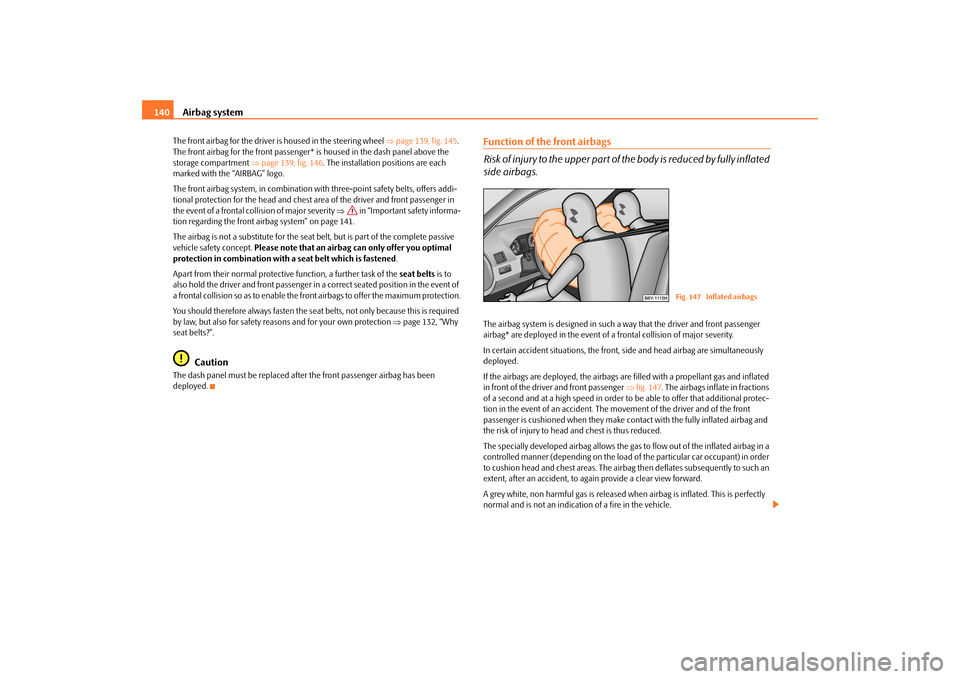
Airbag system 140The front airbag for the driver is housed in the steering wheel ⇒page 139, fig. 145.
The front airbag for the front passenger* is housed in the dash panel above the
storage compartment ⇒page 139, fig. 146. The installation positions are each
marked with the “AIRBAG” logo.
The front airbag system, in combination with three-point safety belts, offers addi-
tional protection for the head and chest area of the driver and front passenger in
the event of a frontal collision of major severity ⇒ in “Important safety informa-
tion regarding the front airbag system” on page 141.
The airbag is not a substitute for the seat belt, but is part of the complete passive
vehicle safety concept. Please note that an airbag can only offer you optimal
protection in combination with a seat belt which is fastened.
Apart from their normal protective function, a further task of the seat belts is to
also hold the driver and front passenger in a correct seated position in the event of
a frontal collision so as to enable the front airbags to offer the maximum protection.
You should therefore always fasten the seat belts, not only because this is required
by law, but also for safety reasons and for your own protection ⇒page 132, “Why
seat belts?”.
Caution
The dash panel must be replaced after the front passenger airbag has been
deployed.
Function of the front airbags
Risk of injury to the upper part of the body is reduced by fully inflated
side airbags.The airbag system is designed in such a way that the driver and front passenger
airbag* are deployed in the event of a frontal collision of major severity.
In certain accident situations, the front, side and head airbag are simultaneously
deployed.
If the airbags are deployed, the airbags are filled with a propellant gas and inflated
in front of the driver and front passenger ⇒fig. 147. The airbags inflate in fractions
of a second and at a high speed in order to be able to offer that additional protec-
tion in the event of an accident. The movement of the driver and of the front
passenger is cushioned when they make contact with the fully inflated airbag and
the risk of injury to head and chest is thus reduced.
The specially developed airbag allows the gas to flow out of the inflated airbag in a
controlled manner (depending on the load of the particular car occupant) in order
to cushion head and chest areas. The airbag then deflates subsequently to such an
extent, after an accident, to again provide a clear view forward.
A grey white, non harmful gas is released when airbag is inflated. This is perfectly
normal and is not an indication of a fire in the vehicle.
Fig. 147 Inflated airbags
s29g.4.book Page 140 Wednesday, June 17, 2009 9:54 AM